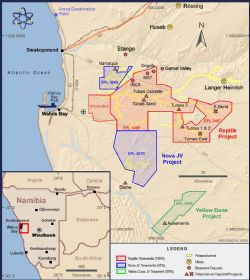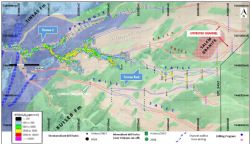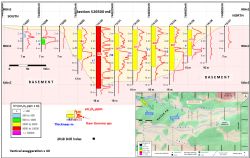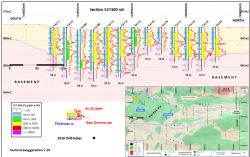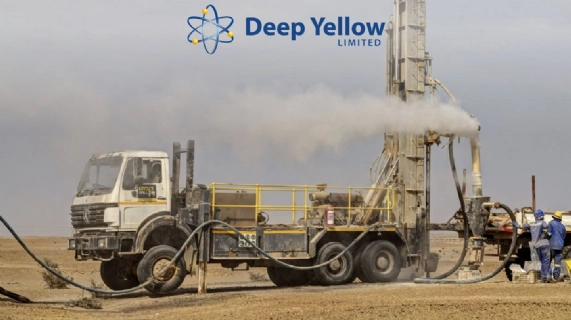
Tumas 1 East Uranium Discovery Expanded Further
Perth, Oct 17, 2018 AEST (ABN Newswire) - Deep Yellow Limited ( ASX:DYL) (
ASX:DYL) ( DYLLF:OTCMKTS) (Deep Yellow) is pleased to announce continued encouraging drilling results on EPL3497 where the recently discovered continuous mineralisation at the Tumas 1 East palaeochannel area (as announced 3 October 2018) has now been further extended and has also identified a new mineralised channel to the north. Broad exploration drilling was also conducted on the smaller tributaries south of the main mineralised tributary which did not identify significant mineralisation. This EPL is held by Reptile Uranium Namibia (Pty) Ltd, part of the group of companies wholly owned by Deep Yellow.
DYLLF:OTCMKTS) (Deep Yellow) is pleased to announce continued encouraging drilling results on EPL3497 where the recently discovered continuous mineralisation at the Tumas 1 East palaeochannel area (as announced 3 October 2018) has now been further extended and has also identified a new mineralised channel to the north. Broad exploration drilling was also conducted on the smaller tributaries south of the main mineralised tributary which did not identify significant mineralisation. This EPL is held by Reptile Uranium Namibia (Pty) Ltd, part of the group of companies wholly owned by Deep Yellow.
HIGHLIGHTS
- Ongoing exploration drilling has extended the Tumas 1 East (Tail 1 tributary) uranium discovery by a further 1.1km
o The overall Tail 1 tributary drilling returned mineralisation from 86 of 121 holes drilled - a 71% success rate of >100ppm eU3O8 over 1m
o 5-17m thick, near-surface continuous mineralisation defined along 4.6km strike length
- Best intersections include:
o TA100 17m at 329 ppm eU3O8 from surface
o TA120 12m at 407 ppm eU3O8 from surface
o TA120 7m at 499 ppm eU3O8 from 4m
- Mineralisation is calcrete-associated hosted within palaeochannels, similar to the Langer Heinrich uranium mine located 30km to the north
In the first 2 weeks of October (since the last drilling update announcement) another 50 RC holes for 563m have been completed increasing the extent of the newly identified mineralised channel east of Tumas 1. Mineralisation definition work will continue in this area longer than originally planned before returning to resource drilling over the highly prospective western extension of Tumas 3. Figure 1 (see link below) shows the paleochannel system and prospect locations.
Exploration drilling upstream of Tumas 1 East has now extended the mineralisation by 1.1km and the total length of mineralised channel in the main tributary, named Tail 1, now occurs over a 4.6km length.
Up to 12 October 2018 a total of 121 holes have been drilled for 1,561m in the Tail 1 area with 26 RC holes for 362m drilled since last reported. These focussed on Tails 1, 2, 3 and the newly discovered Tail 4. Drill spacings vary from 50 to 100m along lines 200 to 800m apart.
Of the 121 holes drilled at Tail 1, 86 have now returned positive results of more than 100ppm eU3O8 over 1m. This reflects a 71% success rate. Average grades at a 100 ppm eU3O8 cut-off are 315ppm and average thickness is close to 6m.
The exploration drilling on the main tributary (Tail 1, see Fig. 2 in link below) is now completed and has outlined a uranium rich channel 4.6km in strike length showing continuous calcrete uranium mineralisation. Channel widths range from 200m to 900m. The mineralisation is located at shallow depth between 0 to 17m below surface. Except for localised hot spots, large parts of this mineralisation do not show any surface radiometric expression.
A drill line across Tail 1 was extended to the north and identified uranium mineralisation greater than 100ppm eU3O8 over 1m in 4 of 5 holes in a new tributary, Tail 4 (see Fig 2). This could add an additional 4km of untested prospective palaeochannel to this target area.
As previously reported, photo and satellite image interpretation had identified further untested channels to the south (Tails 2 and 3 on Fig 2). Exploration drilling testing these tributary channels totalling 24 RC holes and 201m did not identify significant mineralisation in these channels.
Drill hole locations are shown in Figure 2(see link below). Figure 3 (see link below) shows a drill cross-section highlighting the continuity and thickness of the mineralisation. Figure 4 (see link below) shows a drill cross-section extending from the main tributary into one of the northern untested channels (Tail 4).
Equivalent uranium oxide (eU3O8) values as reported here have been determined by Deep Yellow personnel and these will be validated by a competent geophysicist for resource estimation purposes. The equivalent uranium values are based on down-hole radiometric gamma logging carried out by a fully calibrated Aus Log gamma logging system.
The ongoing drilling is aimed at defining the extent of the mineralised system occurring in the Tumas 1 East area before infill drilling for resource definition is commenced.
Appendix 1, Table 1 (see link below) lists the 26 exploration drilling holes at Tumas East returning uranium intersections above cut-off and showing equivalent uranium values in ppm and thickness with hole depth and coordinates provided. Table 2 in Appendix 1 (see link below) lists the 50 drill holes completed from 30 September to 12 October 2018 which are the subject of this release.
Analysis
The results of the ongoing exploration in the Tumas 1 East region continue to be very promising. The current drilling has now defined the extent of the new continuous zone of mineralisation associated with the eastern extension of Tumas 1 in the Tail 1 tributary. As importantly new uranium mineralisation in the north of tributary paleochannel system in the Tumas East area has opened up the potential for further mineralisation in the adjacent Tail 4 tributary.
The known mineralisation at Tumas 1 is now been extended by 4.6km in the Tumas 1 East zone and is demonstrating the potential for discovery of further additions to the mineralisation. The mineralisation expected to be found in tributary channels entering the main channel from the north-east make this a priority region for upgrade of the overall resource base associated with these highly fertile palaeochannels. As previously shown, the uranium mineralisation is not confined to one simple, single channel but rather is associated with a complex palaeodrainage system containing several channels.
The work in the Tumas 1 East area is clearly showing potential to delineate further mineralisation in these newly defined paleochannels occurring within the Reptile Project area. This shallow occurring calcrete-associated uranium mineralisation with its continuous nature is expected to add notably to the overall uranium resource base and is in addition to what was expected to be found in the Tumas 3 West area.
To view tables and figures, please visit:
http://abnnewswire.net/lnk/L2NUHP1V
About Deep Yellow Limited
 Deep Yellow Limited (ASX:DYL) (OTCMKTS:DYLLF) is successfully progressing a dual-pillar growth strategy to establish a globally diversified, Tier-1 uranium company to produce 10+Mlb p.a.
Deep Yellow Limited (ASX:DYL) (OTCMKTS:DYLLF) is successfully progressing a dual-pillar growth strategy to establish a globally diversified, Tier-1 uranium company to produce 10+Mlb p.a.
The Company's portfolio contains the largest uranium resource base of any ASX-listed company and its projects provide geographic and development diversity. Deep Yellow is the only ASX company with two advanced projects - flagship Tumas, Namibia (Final Investment Decision expected in 1H/CY24) and MRP, Western Australia (advancing through revised DFS), both located in Tier-1 uranium jurisdictions.
Deep Yellow is well-positioned for further growth through development of its highly prospective exploration portfolio - ARP, Northern Territory and Omahola, Namibia with ongoing M&A focused on high-quality assets should opportunities arise that best fit the Company's strategy.
Led by a best-in-class team, who are proven uranium mine builders and operators, the Company is advancing its growth strategy at a time when the need for nuclear energy is becoming the only viable option in the mid-to-long term to provide baseload power supply and achieve zero emission targets.
Importantly, Deep Yellow is on track to becoming a reliable and long-term uranium producer, able to provide production optionality, security of supply and geographic diversity.
| ||
|



